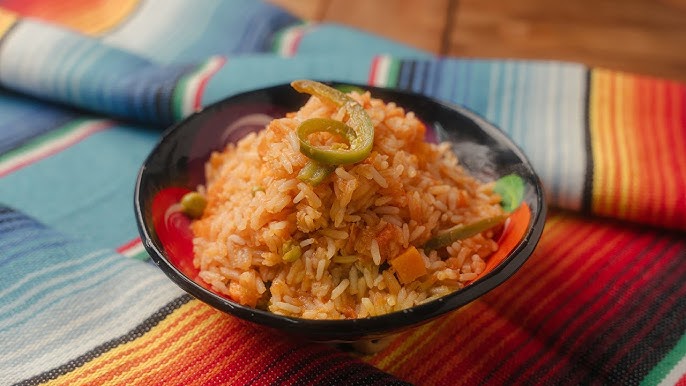Red Rice Recipe: If you’re someone who loves experimenting with healthy alternatives to traditional staples, red rice is your new best friend. Earthy, nutty, and packed with nutrition, red rice is more than just a side dish—it’s a wholesome experience.
In this guide, we’ll take you through a step-by-step process to prepare delicious red rice that’s as good for your taste buds as it is for your body.
What is Red Rice?
Red rice is a type of whole grain rice with a distinctive reddish color, thanks to its anthocyanin content—the same antioxidant found in blueberries and red cabbage. Unlike white rice, red rice retains its outer bran layer, giving it a slightly chewy texture and a rich, nutty flavor. It comes in several varieties, including Himalayan red rice, Thai red cargo rice, and Bhutanese red rice, each with its own flavor profile and cooking time.
What sets red rice apart isn’t just its color. This rice is less processed, making it a healthier choice. Because it keeps the bran and germ, red rice has more fiber, vitamins, and minerals compared to white or even brown rice. It’s perfect for anyone looking to upgrade their diet without giving up on taste.
Red rice can be used in everything from pilafs and salads to curries and stir-fries. Its bold color and taste make it a fantastic centerpiece for any dish.
Nutritional Benefits of Red Rice
Wondering why you should switch to red rice? The answer lies in its impressive nutritional profile:
- High in fiber: Aids digestion and helps in maintaining a healthy gut.
- Rich in antioxidants: Anthocyanins help fight free radicals and reduce inflammation.
- Low glycemic index: Red rice releases sugar slowly, making it ideal for diabetics.
- Packed with iron and zinc: These minerals are essential for a strong immune system.
- Gluten-free: A safe choice for people with gluten sensitivity or celiac disease.
Including red rice in your diet can help with weight management, improve heart health, and even lower cholesterol. It’s a great way to keep meals both exciting and health-conscious.
Ingredients Needed
Basic Ingredients
Let’s start with the essentials. To make a basic yet delicious red rice dish, here’s what you’ll need:
- 1 cup red rice: Choose your preferred variety like Bhutanese or Thai red rice.
- 2 ½ cups water: Adjust based on the type of rice and your preferred texture.
- ½ teaspoon salt: To enhance the flavor.
- 1 tablespoon olive oil or ghee (optional): Adds a rich taste and prevents sticking.
That’s it! These simple ingredients will give you a basic bowl of fluffy, perfectly cooked red rice. However, the beauty of red rice is in its versatility—you can build from here.
Optional Add-Ons for Extra Flavor
Want to jazz things up a bit? Consider these optional ingredients to bring more depth to your dish:
- Bay leaves or cinnamon stick: For an aromatic twist.
- Garlic and onions: Sauté them before adding rice for a deeper flavor base.
- Vegetables like carrots, peas, or bell peppers: Add color, nutrients, and crunch.
- Lemon zest or juice: A splash of acidity brightens the overall flavor.
- Coconut milk: For a creamy, tropical flair.
- Chopped herbs like cilantro or parsley: Perfect for garnishing.
Feel free to customize the rice based on what’s available in your kitchen or to match the theme of your main dish. Red rice is extremely forgiving and pairs well with both bold spices and subtle flavors.
How to Prepare Red Rice
Step 1: Rinse and Soak the Red Rice
This is a crucial first step that you don’t want to skip.
- Rinse thoroughly: Put your red rice in a large bowl and rinse under cold water. Swirl the rice with your fingers, drain, and repeat 2-3 times until the water runs clear. This helps remove excess starch and ensures your rice cooks evenly.
- Soak for at least 1 hour: Red rice has a tougher bran layer, so soaking is important. It helps soften the grains and shortens the cooking time. If you’re in a rush, even a 30-minute soak makes a difference.
Soaking also ensures the rice cooks uniformly and results in a fluffier, less sticky texture. Once soaked, drain the water and set the rice aside.
Step 2: Cooking Methods – Stovetop, Rice Cooker, or Instant Pot
There are several ways to cook red rice, and the method you choose depends on your preference and available appliances.
Stovetop Method (Most Traditional):
- Add soaked rice and 2.5 cups of water into a saucepan.
- Bring to a boil, then reduce heat to low and cover with a tight-fitting lid.
- Simmer for 30-40 minutes or until water is fully absorbed.
- Let it sit off heat for 10 minutes before fluffing with a fork.
Rice Cooker Method:
- Add rinsed and soaked rice to the cooker with water and salt.
- Set it to the brown rice setting or standard cook mode.
- Once done, let it rest for a few minutes before serving.
Instant Pot Method (Quick & Easy):
- Use a 1:2 rice-to-water ratio.
- Pressure cook on high for 20 minutes, followed by a natural pressure release.
- Open, fluff, and enjoy!
Each method has its pros and cons. The stovetop gives you the most control, the rice cooker is hassle-free, and the Instant Pot is perfect if you’re short on time.
Step 3: Fluffing and Serving the Rice
After cooking, the rice needs a bit of rest before you dig in.
- Let it sit with the lid on for about 10 minutes.
- Use a fork to fluff the rice gently. This separates the grains and releases trapped steam.
- Taste and adjust salt if needed before serving.
Red rice is incredibly versatile. You can serve it as a base for curries, mix it into salads, or use it as a healthy side dish for grilled meats or tofu. It also works great in meal prep bowls with some sautéed greens, a boiled egg, and a drizzle of sauce.
Tips for Perfect Red Rice
Common Mistakes to Avoid
Cooking red rice might seem straightforward, but a few missteps can ruin the whole experience. Here are the most common mistakes and how to avoid them:
- Skipping the soak: Red rice has a harder outer bran than white rice. If you skip soaking, you’ll end up with undercooked or unevenly cooked grains. Always soak for at least 30–60 minutes.
- Using too little or too much water: Red rice needs more water than white rice. Too little water, and the rice burns or stays hard. Too much, and you’ll end up with mush.
- Not letting it rest: Red rice needs time to steam after cooking. Don’t skip the 10-minute rest. This helps the grains firm up and absorb any remaining moisture.
- Stirring while cooking: Resist the urge! Stirring breaks the grains and turns the rice sticky. Let it cook undisturbed.
- Not rinsing the rice properly: If you don’t rinse off the excess starch, you might get clumpy rice.
Understanding and avoiding these errors can mean the difference between perfect fluffy grains and a gummy, unappetizing mess. Red rice is a little high-maintenance, sure—but totally worth the extra effort.
Flavor Enhancements and Pairings
One of the best things about red rice is its ability to adapt. Its bold, nutty flavor is a solid base, but with the right add-ons, it can shine as the star of your meal. Here are a few ideas to take your red rice from good to gourmet:
1. Spice It Up:
- Sauté red chili flakes, cumin, or turmeric in a bit of oil before adding the rice for a spiced twist.
- Mix in garam masala or curry powder for a South Asian flair.
2. Add Aromatics:
- Cook red rice with garlic, onions, or shallots for a richer flavor.
- Add a bay leaf or a stick of cinnamon while cooking.
3. Cook in Broth:
- Swap water with vegetable or chicken broth for extra depth.
- Try coconut milk for a creamy, tropical variation.
4. Mix in Veggies or Legumes:
- Stir in sautéed mushrooms, bell peppers, carrots, or peas.
- Add cooked lentils or chickpeas for a protein boost.
5. Finish with Herbs and Citrus:
- A sprinkle of cilantro, parsley, or green onions can make the dish feel fresh.
- A dash of lemon juice or zest right before serving lifts the flavor.
Best Pairings:
- Curries (both meat and vegetarian)
- Grilled meats or fish
- Stir-fried vegetables
- Bean stews or lentil soups
- Tofu or tempeh dishes
The goal is to let the nutty richness of the red rice complement the meal, not get lost. These enhancements make the dish flexible enough for daily meals or dinner parties.
FAQs about Red Rice Recipe
1. Can I cook red rice without soaking it?
Technically, yes—but it’ll take longer to cook and might not turn out as fluffy. Soaking helps reduce cooking time and improves texture.
2. Is red rice better than brown rice?
Both are whole grains and nutritious, but red rice typically has more antioxidants due to its rich color. It’s also nuttier and chewier in texture.
3. How do I store cooked red rice?
Let it cool completely, then store it in an airtight container in the fridge. It lasts up to 4–5 days. You can also freeze it for up to a month.
4. Can I use red rice in desserts?
Yes! In some cultures, red rice is used in sweet dishes with coconut milk, jaggery, or fruit. Its chewy texture works well in puddings and porridge.
5. Why is my red rice still hard after cooking?
You likely didn’t soak it long enough or didn’t use enough water. Make sure to follow the soaking step and maintain a good rice-to-water ratio.
Conclusion
Red rice isn’t just another health fad—it’s a delicious, nutrient-packed alternative to white and brown rice. Whether you’re cooking it plain or dressing it up with spices, veggies, or herbs, red rice brings a hearty and wholesome vibe to your plate.
Its preparation might require a bit more time and attention, but the result is undeniably worth it. Rich in antioxidants, fiber, and essential minerals, it’s a great addition to a balanced diet and suitable for a wide range of eating lifestyles—vegan, gluten-free, diabetic-friendly, and more.
By following this step-by-step guide, you now have all the tools to cook red rice perfectly every time. Don’t be afraid to experiment with flavors, mix-ins, and cooking methods. Once you get the hang of it, red rice can become your go-to grain for everything from quick weeknight dinners to festive family meals.



